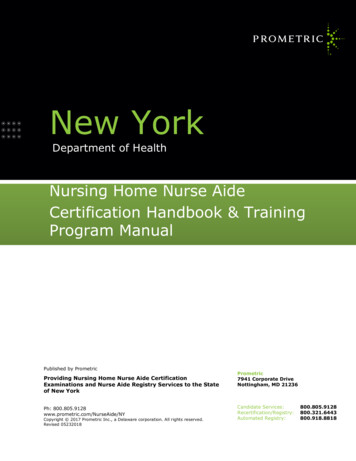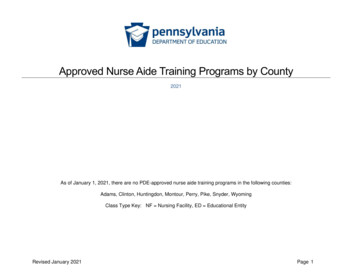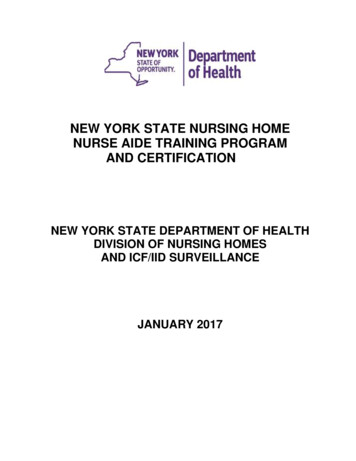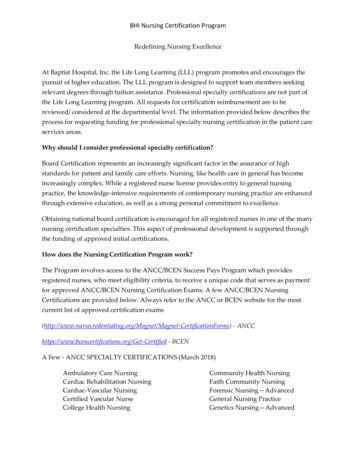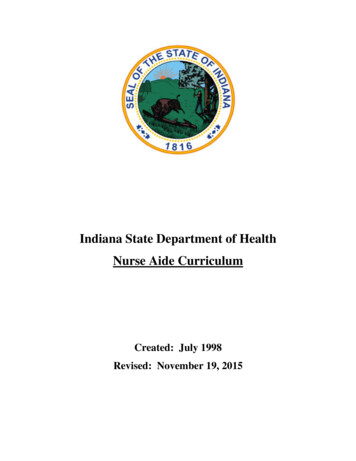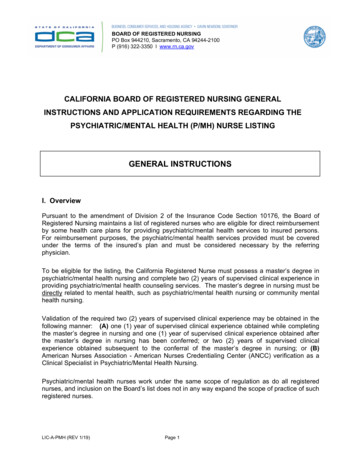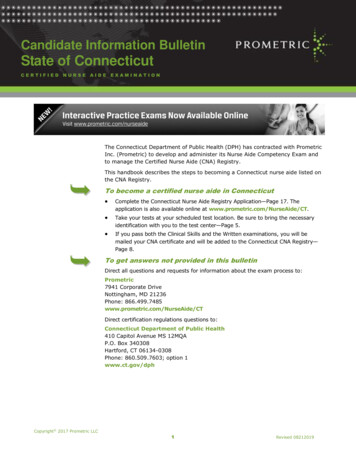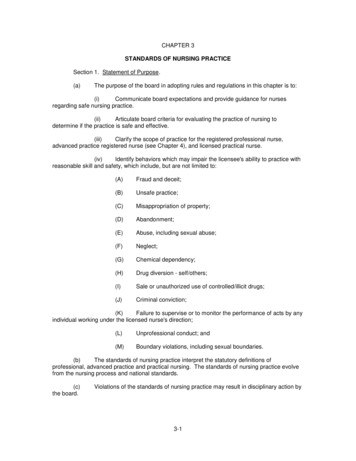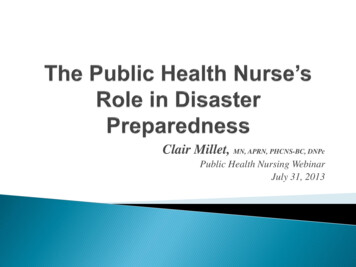
Transcription
Clair Millet, MN, APRN, PHCNS-BC, DNPcPublic Health Nursing WebinarJuly 31, 2013
Discussthe types of disasters, including natural andhuman made Identifywhat Emergency Support Functions (ESFs) ofthe National Response Framework apply to publichealth nursing during disaster Describethe public health nursing role in disasterpreparedness
Images from: LA DHH
Disaster- dis·as·ter n.a.a sudden calamitous event bringing great damage, loss, ordestruction; broadly : a sudden or great misfortune or failureb.An occurrence causing widespread disruption, destruction anddistress requiring external assistance;Image from Google Images
A disaster is present when need exceeds resources!A response NEED that is greater than the RESOURCESthat are available!
Human-Made EventsWarfare, Transportation accidents,Bombing, Structural collapse, Fires,Pollution, Hazardous MaterialsIncident (Oil Spill), Civil unrest,Terrorism (CBRNE incidents), Cyberattacks, Airplane crash, Water supplycontaminationNatural DisastersEarthquake, Volcano, Hurricane,Flood, Tornado, Landslide, Avalanche, Pandemics/Epidemics, Tsunamis,Extreme heat and cold, etc.Images from LA DHH and retrieved fromGoogle Images and Microsoft Office clip art
2002 – U.S. Department of Homeland Security created2003 – Homeland Security PresidentialDirective-8/Presidential Policy Directive (PPD)-8(2011) National Preparedness 5 Preparedness Mission Areas:1.2.3.4.5. PreventionProtectionMitigationResponseRecovery2004 – National Response Plan (NRP)2006 – Pandemic & All Hazards Preparedness Act
2008 – National Response Framework (NRF evolvedfrom NRP) National Incident Management System (NIMS) – PPD 5 toinclude Incident Command System (ICS)Emergency Support Functions (ESFs): 15 total ESF 8 : Public Health & MedicalTwo national documents to be aware of that guidedisaster preparedness, response and recovery: Homeland Security Presidential Directive 21 Public Health & Medical Preparedness National Health Security Strategy
Image retrieved from Google Images
Public Health Nurses play a critical role in coordinatingand implementing any disaster response plan Largest segment of the public health workforce; Most trustedprofession Community advocates Unique skill sets Must understand the disaster cycle and be able to beintegrated at every phase
Images from: LA DHH
Services provided should be consistent with the scopeof practice; PHNs clinical knowledge regardingdisease pathophysiology and epidemiology inconjunction with community assessment skills canserve a crucial role in emergency preparedness andresponse Participation in healthcare policy development
Images from: LA DHH
All-hazardsmitigation Structural & Nonstructural Deter potential threats Take action to eliminate threats
Hazard vulnerability assessment/risk assessment Increase security Increase testing specific to the event; increasedsurveillance Mass prophylaxis/immunization Assessment & identification of potentialhazards/vulnerabilities Isolation & quarantine Halting of CBRNE threats
Personal Professional Disaster competencies International Council of Nurses (ICN) Framework of Disaster NursingCompetencies (ICN and World Health Organization, 2009) Public Health Preparedness and Response Core Competencies(ASPH, 2010) Community Training, Drills & Exercises
Images from: LA DHH and Google Images
National Response Framework; NIMS; ICS Event begins and ends at the local levelPublic health nurses bring leadership, policy, planning andpractice expertise to disaster preparedness & response First responders; triageEpidemiology; surveillanceRapid needs assessmentRisk communicationAssist with medical surge capacity
Images from: LA DHH
Flexibility is important; attempt to return to“usual” operations. Community assessment Psychological support The public health nurse is the community andclient advocate
Images from: LA DHH
The Role of Public Health Nursesin Disaster Preparedness, Response, and RecoveryA Position PaperAssociation of Public Health Nurses (APHN)Public Health Preparedness CommitteeGoal for Completion: September 2013APHN website www.phnurse.org
ationEvaluationPrevent a disasteror emergency;Minimizevulnerability toeffects of an event.Assess a group ofelderly citizens fortheir awarenessabout preventingheat stroke.Develop communityeducation plan toincrease awarenessabout preventingheat stroke.Conduct communityeducation activitiesto increaseawareness aboutpreventing heatstroke.Evaluate communityeducation activitieson preventing heatstroke.Assure capacity torespond effectivelyto disasters andemergencies.Assess thepopulations at riskfor special needsduring a disaster.Develop plans tocare for specialneeds populationsduring a disaster.Conduct training,drills and exercisesrelated to care ofspecial-needspersons.Evaluate plans forserving populationswith special needs.Provide support topersons andCommunitiesaffected bydisasters andemergencies.Serve on a responseteam to determinethe impact andspecific health needsof hurricanesurvivors. Triagevictims.Develop plans torotate staff onresponse teams toprevent stress andburnout amongresponders.Deploy staff toshelters after ahurricane, inaccordance withlocal and/or stateemergency responseplans.Participate in afteraction reviewsand/or debriefings toevaluate quality ofhealth servicesprovided andlessons learned.Restore systemsto functional level.Serve on team toassess communityassets and potentialfor recovery from arecent flood.Collaborate withpartners andcommunity leadersto plan long-termrecovery prioritiesafter a flood.Participate inrestoring communityservices after aflood.Serve on team toevaluate long-termimpact on personsdisplaced by a flood.Source: ASTDN 2007
National, Public Health, and Nursing References for understandingPublic Health Nurse Practice in Disaster Preparedness, Response, and RecoveryAmerican Nurses Association (ANA). 2008. Adapting standards of care under extremeconditions: Guidance for professionals during disasters, pandemics, and other extremeemergencies. ocuments/ASCEC WhitePaper031008FINAL.pdfAssociation for Community Health Nursing Educators (ACHNE) Task Force on DisasterPreparedness. 2008. Disaster preparedness white paper for community/public health nursingeducators. nessWhitePaper.pdfAssociation of Schools of Public Health (ASPH). 2010. Public health preparedness &response core competency mpetencyModelWorkforce-Version1.0.pdfCenters for Disease Control and Prevention (CDC). 2012. Public health preparedness:2012 state-by-state report on laboratory, emergency operations coordination, and emergencypublic information and warning 12/documents/2012%20State-ByState Preparedness Report.pdf
CDC. 2011. A national strategic plan for public health preparedness and response.http://www.cdc.gov/phpr/publications/A Natl Strategic Plan for Preparedness.htmCDC. March 2011. Public health preparedness capabilities: National standards for state andlocal planning. http://www.cdc.gov/phpr/capabilities/dslr capabilities july.pdfFederal Emergency Management Agency (FEMA). 2013. Presidential Policy Directive (PPD)8 components: National preparedness goal, National preparedness system, Nationalplanning frameworks. sidential-policydirective-8#NPFFEMA Emergency Management Institute (EMI). 2013. Independent study program tional Council of Nurses (ICN) and World Health Organization (WHO). 2009. ICNframework of disaster nursing rNursing Competencies lite.pdf
Institute of Medicine (IOM). 2012. Crisis standards of care: A systems framework forcatastrophic disaster response. http://www.nap.edu/catalog.php?record id 13351National Commission on Children and Disasters. October 2010. 2010 Report to the presidentand congress, AHRQ Publication No. cdreport.pdfRESOLVE, Inc. 2012. Transforming public health: Emerging concepts for decision makingin a changing public health world. mlTrust for America’s Health. December 2012. Ready or not: Protecting the public fromdiseases, disasters, and bioterrorism. http://www.healthyamericans.org/report/101/U.S. Department of Health and Human Services (DHHS). 2012. Implementation plan for thenational health security strategy of the United States of uthority/nhss/ip/Pages/default.aspx
Clair Millet, MN, APRN, PHCNS-BC, DNPcDirector of NursingLouisiana Department of Health & Hospitals Office of Public HealthClair.Millet@La.Gov(225) 342-7867
New England Alliance for Public Health WorkforceDevelopment Boston University School of Public Health Massachusetts Association of Public Health Nurses(MAPHN)
Please visit: www.maphn.org/webinars Click on the "Evaluation Forms" link which willtake you to the evaluation form in SurveyMonkey Fill out your evaluation in Survey Monkey and atthe end there will be instructions to “click here” toget your CE Certificate. Click to open up yourcertificate first and then submit your evaluation. Thank you!Questions please email: educationchair@maphn.org
The link to the archives and the PP slides areavailable athttp://www.masslocalinstitute.org/?page id 2888 To viewthe archive select the session you wish to view, click onthe right facing arrow below the large black viewing boxand the video will play. You can also access the archive link and the PPslides on the MAPHN website athttp://www.maphn.org/nea2013
Disaster competencies - International Council of Nurses (ICN) Framework of Disaster Nursing Competencies (ICN and World Health Organization, 2009) Public Health Preparedness and Response Core Competencies . Guidance for professionals

